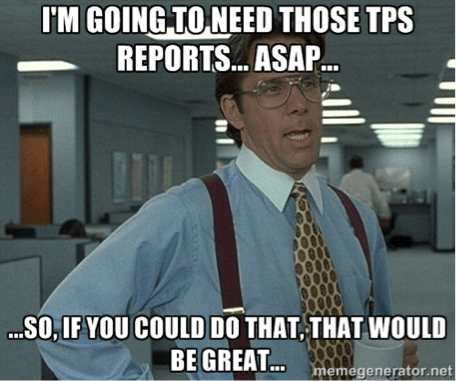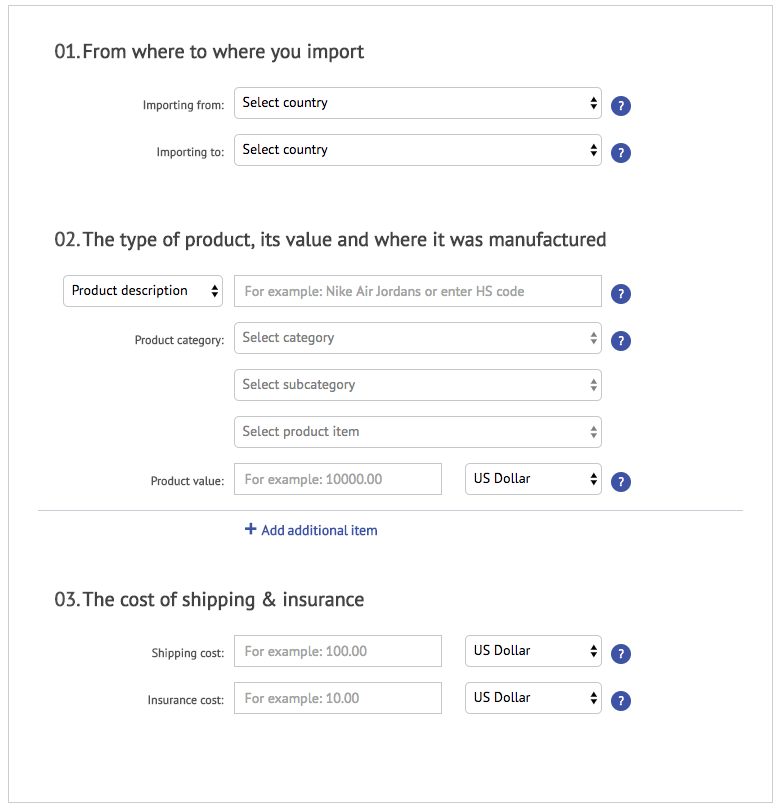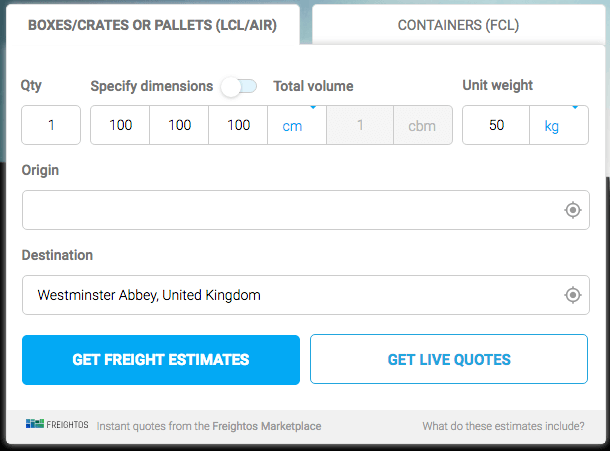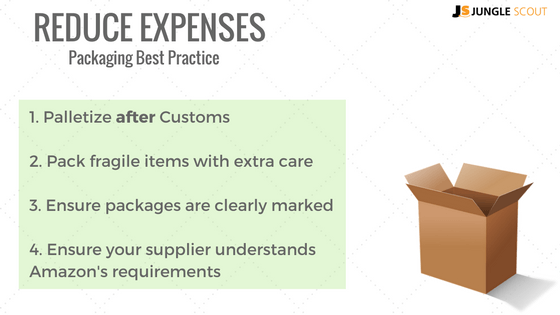Blog: Crash Course: International Freight for Amazon FBA Explained
Crash Course: International Freight for Amazon FBA Explained
Freight and shipping is a pretty big topic for Amazon sellers, but it can become a complex one and in some cases its things like freight which can put a potential business owner off making the decision to take a slice of the Amazon FBA pie.
To demystify the topic and give sellers enough information to navigate the field of freight and shipping, we have asked John Edmonds of Freightos to share a crash course on International Freight! Strap yourselves in, here it is:
What’s your scariest freight horror story? Getting crushed by customs because of late paperwork? Hidden freight surcharges obliterating the profit margin? Container lost at sea (thousands a year)? Slow strangulation by Bills of Lading, 10+2 Filing and TPS reports – Office Space, anyone?

So many online sellers stick to importing the same way they’ve been importing for years because – hey, better the devil you know, right? Which is too bad. There are plenty of online businesses that are literally making millions by cracking open the shell that is international freight.
We’ve mapped out a crash course that takes you through exactly what you need to know at each step in the freight import process. Seasoned importers? Keep reading – there should still be some gems in here to help.
A word of warning. These are the freight tips you need, not the freight tips you want. Between customs bonds, incoterms and hazardous materials, freight can be a challenge. Put on your sweatband, grab a Gatorade, and tighten those shoelaces. Frictionless importing awaits.
Restrictions: “Freightable” Or Debatable?
Can you ship it? Here’s your first challenge. You’ve found a promising product that looks like your golden egg. But before you look for suppliers, make sure that customs (and the other agencies that take an interest in what’s coming into the US), don’t prohibit or restrict its import. Also make sure it’s not a hazardous material, prohibited cargo on planes or ships.
It’s not only exploding hoverboards that can get you up ship creek. There are many regularly imported products, like cosmetics, or anything with metals (that includes aluminum), that may be affected. Even a seemingly innocuous product, like colored pencils, may be subject to hefty anti-dumping duties.
A perfectly safe product can also be nixed by its packaging. Those leather-trimmed sunglass cases could require wildlife approval. Pallets from many countries, like China, need to be stamped as fumigated. A mistake here becomes expensive, because the Department of Agriculture will refuse entry until they have been re-palletized.
Finally, to stay on the right side of IP law you need to consider whether your product or packaging is subject to a patent, trademark or copyright.
How do you check up on your product?
Ask!
Speak with a forwarder for help, unless you fancy starting the long journey through Customs documentation.
Search Google
A quick google search should also soon pick up any issues importing that product. Then, use an online duties estimator, to check out how significant any duty might be. For example, dutycalculator.com. Bear in mind that customs charges (bonds, duties, etc) will not be included in a forwarder’s quote: you will be paying these directly. It’s easy to get confused on this, though, because forwarders charge several processing fees for customs process tasks that they perform on your behalf.

Find out if IP, copyright and trademark infringement applies
You may not realize if you are potentially breaching a patent. If your product is similar to a big brand, check that company’s website for patent numbers, then google search on that number to find what the patent covers. If at all unsure, get legal advice.
Is your product freightable? Let’s keep going.
First Shipment: Can I Try Before I Buy?
Find the right supplier. Trade shows were once the go-to method to do this (like the Canton Fair), but sites like TradeIndia, Global Sources and, of course, Alibaba, are becoming the gold standard.
Once you’ve found that supplier, make sure to try before you buy. If you’re a serious buyer, suppliers may provide free samples but charge you on the shipping; that will cost you say $50 by express shipping. Now you can check the product, while making sure that the packaging meets Amazon’s requirements.
Once you have those products ready to prep, it’s time to test the market. Do your thing on Amazon.
Are We Starting Off On Good Terms? (The Incoterm Headache)
Great news! Your first order sold faster than $30 Justin Bieber tickets at a high school fundraiser. So you’re back with the supplier, bargaining to get the best buy price and payment terms for the next inventory order.
Freight terms (called incoterms in freight jargon), can easily sour the sweetest deal. There are 11 of them that your supplier and you could choose from that govern what responsibilities and liabilities each of you assume at the each stage of the shipment.
If your profit margin allows, you might go for simple: let the supplier handle most (or all) of the shipment. Unfortunately, less-experienced importers don’t often get that option, with one exception – if the shipment is to be couriered. That’s because most Chinese suppliers will only work with three freight terms:
- Ex-Works (EXW): You pay for the entire shipment, beginning with pickup at the supplier’s warehouse.
- Free On Board (FOB): The supplier pays Chinese customs and freight, including loading onto the ship. This only works for full containers.
- Free Carrier (FCA): Suitable for smaller loads that need to be dropped off near the port to be “consolidated” with other shipments to fit into a container or a plane’s hold. The supplier pays Chinese customs and the transporting from the warehouse to the consolidation center. You will be covering the minor charges for consolidation and loading. Many suppliers aren’t aware of this subtle difference between FCA and FOB and think that it is all FOB.
Freight terms are called “Incoterms” in freight jargon
Many Chinese suppliers work in partnership with local companies to get their goods to port, and cleared through Chinese Customs. These partners usually do this better and cheaper than your US forwarder could arrange. So if you can, take advantage. FCA and FOB are good freight terms for you. In each of these three freight terms, you will be paying the international transit (ship or plane) and all the charges once the shipment lands in the US.
Suppliers do take on more responsibility in the other eight freight terms, but steer clear of them. Many freight horror stories happened because they are used without fully understanding their ramifications. There’s plenty more to learn about incoterms, but for now, this is all you need to know.
So which of the three is best for your shipment? Hold that thought. Before you can do the calculations, you need to first pin down the largest freight cost, from port to port.
How To Ship: Best Practice
Here’s some rules of thumb for the international freight:
- Go courier for packages less than 150 kg. It will cost you about $6/ kilo.
- Go for air for anything between 150 kg and 500kg. That will run you about $4 per kilo.
- Above 500 kg, you’re looking at ocean freight – at around 50 cents/kg.
To give some idea of magnitude, a shipment that might cost $2,000 by air, may cost only $800 by ocean. Sometimes the difference looks even bigger, but check whether ancillary charges are included. There’s more of them with ocean freight.
Going by international courier is often called express freight. A major courier like DHL will pick up from the warehouse, so this is an EXW incoterm. Customs duties only apply if the value of the goods is over $800, and some suppliers may be prepared to manage the whole shipment, probably excluding any customs duties.
A shipment that might cost $2,000 by air, may cost only $800 by ocean
They may do this for express freight, but not ocean freight or air freight, because going by courier is a much simpler process. Even clearing customs is much simpler. And being a simple process means that courier rates can be calculated without a formal quote. So, use a courier’s online freight calculator to work out whether you can afford the speed of couriering.
Got a pressing deadline, but priced out of express freight? Ocean freight probably won’t work. Importing from China to the US this way can take up to a month. Standard air generally takes 8-10 days, while express air can deliver in less than a week. Plus, no matter how much of a rush you’re in, some products actually won’t be allowed on planes, like heavy duty lithium batteries.
If air cargo is still too pricy, there is yet another option. It’s a fairly new hybrid, cheaper than air, but often not that much slower. It’s usually called expedited freight, and only some forwarders offer it. It works by streamlining ocean freight processes and only tying in with the faster ocean services and premium trucking services.
If air cargo is too pricy, try expedited freight, which is faster than Ocean Freight!
Landed Costs: Do It At “All Costs”
Ok, you’re pinned down the port to port bit. Back to the deal.
Your supplier has just offered a great discount to close the deal but only if you pick up the shipment from his warehouse (EXW, remember?), instead of getting it on a ship himself (FOB). Don’t be too hasty. You should first check out whether the changed freight costs won’t sour this great offer.
That means finding out what the freight costs would be for each scenario, factor in an extra $100 export licence for EXW only (if the factory can’t provide the licence), and then doing the math on each deal.
So what are the different freight costs? Forwarders don’t like providing rough estimates, because there are so many variables to freight, some of them volatile. That said, this freight rate estimator is pretty accurate, because it is based on currently available rates.

The Freightos freight rate calculator
If calculating landed costs seems like too much effort, just go for FOB.
Packaging: Padding The Product, Not Your Costs
You can't stop emailing your supplier just yet.
Excessive packaging adds space and weight. That potentially increases freight costs, especially for air freight. Less experienced importers don’t really have much leeway to negotiate cost-effective packaging. Fortunately, your supplier is probably using (somewhat) cost-effective packaging, because they are also driven by costs, and they save on cardboard boxing if they can fit 100 widgets into a box instead of 50.
Here’s four easy ways where you can make a difference with packaging:

Adding pallets to air freight will increase freight costs. Also, don’t forget that wooden pallets may need fumigation, delaying shipping. Instead, have the shipment “palletized” once they have cleared Customs, to conform with Amazon’s packaging requirements.
Check that fragile products have extra packaging. Double boxing is great since it adds extra cushioning, both inside and outside the box.
Until you’re importing entire containers of stock, make sure that your packages are clearly marked. That’s because your shipment will first be consolidated with other shipments in a container or with other air cargo shipments, and it’s easy for cartons and boxes to get mixed up. Be careful not to tip off thieves if you are shipping something that might be attractive for them. Ensure any brand identification, or any other labeling that might tip them off, is removed.
Also ensure that the following is written on the outside of cartons: carton count, gross weight, net weight, country of origin, FBA shipment labels (or any other tracking label).
Finally, make sure that supplier really understands Amazon’s packaging requirements. Check the samples they sent, or if you skipped that step, ask them to email photos of the finished and the packaged product. You should have the first shipment, at least, physically checked at prepping stage.
Expert Help: Going Forward(er) Not Backward
Cross the supplier off the list – you’re done with them (until the next shipment). Time for shipping. If you’ve already got a great relationship with a freight forwarder, they will have helped out with some of the earlier points. If you don’t have a forwarder, now’s the time to find one.
You need a partner who knows how international shipping works. A good forwarder is like a good travel agent for moving your cargo. They will give useful advice, book the shipments, manage the flow of paperwork, and step in if things start to go wrong (and with freight, ship happens).
With freight, ship happens!
Thinking you can save some money without a forwarder? Think again. Many suppliers offer to arrange the shipment as far as the port in the U.S. The importer mentally adds on local trucking costs, and it looks like a great deal. But there are some other significant costs involved, like clearing the goods through Customs, where things can go very wrong for amateurs. Having a forwarder involved in the process should steer you clear of pitfalls like these. And that’s also why less experienced importers shouldn’t consider getting by with just a customs broker.
Having a freight forwarder helps you to avoid pitfalls and extra costs! #amazonfba Click To TweetThere are over 100,000 freight forwarders in the world, so finding the right one for you can be hard. Start with word of mouth. If you have a friend who is happy with their forwarder, chances are that they will be a good fit for you as well. Here’s a few other tips for finding the right forwarder:
- Many freight companies are still a little old-school, so build a few days into your workflow when getting price quotes from forwarders. Many forwarders are also reticent to work with small customers so asking for quotes from a couple of extra companies will ensure that you’ll get enough quotes to compare.
- Don’t be put off by smaller local forwarders. They don’t get caught up with big customers, so they are much more likely to reply to your spot quote, and to have more time for staying on top of your shipment.
- Online platforms can help speed up the process. The Freightos Marketplace allows you to instantly compare quotes from reviewed forwarders. Some forwarders, like UPS Supply Chain Air, do provide online quoting.
Freight Quotations: “Can I Quote You On That?”
When you start getting freight quotes, make sure you have all the information at the gate. Give your supplier (remember him?) a call and get him to send the Packing List and Commercial Invoice before you start.
Okay, grab a pen. You’re going to need:
- Buyer and Seller contact details, including the physical addresses for pickup and delivery. Check Amazon Seller Central to see which fulfilment centers to deliver to (or just the one if you are using Amazon’s Inventory Placement program).
- Total weight (from the Packing List).
- Dimensions of every box, pallet, etc. Work out the total cubic volume too.
- Product description (should be on the Commercial Invoice, but check anyway, using an HS Code lookup).
- Shipment value, and date that the shipment will be ready.
- If shipping to Amazon, whether your stock is to be co-mingled (your new forwarder may also be prepping for you).
- Your US company Tax ID (required to be a Customs “Importer Of Record”).
Pass on the information to the forwarders and wait for the shipping options to trickle in. Before accepting the best quote, get their assurance that they are experienced with Amazon’s receiving processes. You don’t want to fall at the last hurdle. Check that they have allowed sufficient time when working from the shipment ready date to the requested Amazon delivery date, factoring in buffers for delay.
Cargo Insurance
Heard about the container containing plastic bath toys that fell overboard in 1992, setting 20,000 bath ducks free to float the oceans? Ernie and Bert’s little rubber buddies are still bobbing up on the planet’s shores. Great news for oceanographers, who have learned a lot about currents. Not so great news for the importer.
Take it from me. You need cargo insurance. If your goods are damaged or disappear, standard forwarder and carrier liability probably means you’ll get a paltry $2.00/kg (2.2lbs). You don’t need a calculator to know that you’ll be out a nice sum of money with that alone.
Cargo insurance is internationally standardized. And with forwarders rates usually being competitive with insurance companies, you’re probably wasting time shopping around. But make absolutely sure that your forwarder arranges comprehensive cargo insurance. Nothing less will do. You should also pay the little extra to reduce the cost of making a claim.
At this level of coverage, the premium is calculated at around 60c for each $100 of insured value (your buy price, not the retail price). As you can see, it’s not a material cost that you need to factor in when estimating landed cost. And having it is well worth it.
Paperwork: Treat It Like A Mortgage, Not The Toaster Manual
Hey, you’re racing through this: product, supplier, forwarder, mode, insurance. But slow down, sparky–you still got some paperwork to go over. And, unfortunately, you can’t treat this lightly.
Be prepared for forms. Your forwarder will steer you through the paperwork process anyway, but ask them to take you through the process early on.
The first big form is your Shipper’s Letter of Instruction. Take the time to carefully complete it. Then check it… twice. Information you put down will be transferred to other forms and set off other processes which are unforgiving of errors: the shipment and Customs clearance. They say that a picture is worth a thousand words: if you can, include photos of the product. You can often get these from the Packing List.
Be honest with the shipment value. Trying to cheat Customs is breaking the law. Besides, your chances are like Russian Roulette. You could get away with it and save a few pennies, or it could blow up in your face.
You’ll also have to sign a Power of Attorney form (POA), so that the forwarder can act on your behalf with Customs, as well as a Customs Terms and Conditions Service Agreement. Some forwarders will also require you to complete a Credit Application form.
“Bond. Customs Bond”
Last (complicated) step, I promise.
You can’t import into the US without buying a bond – essentially a Customs insurance policy that the insurer pays Customs should an importer fail to pay any duties, taxes, fines or penalties due.
That said, you do get some choice. You can either go for an annual continuous bond at $500, or a single entry bond at 0.5% of the value of the goods (minimum $50). If you are using ocean freight and go for the single entry bond option, you will also have to pay an import security filing (ISF) bond, currently $75. The ISF bond works the same as a customs bond for the other agencies with an eye on imports, like the FDA. The single entry bond/ISF bond path option does require the forwarder to do more work.
And still more choice, this time with another aspect of the customs process – payment. Unless you will only rarely be importing, you should develop your own account relationship with Customs authorities. In fact, your forwarder will probably recommend this. Customs controls the clearance process, and there is often only a short period of time for transactions. Your forwarder can’t pay directly with ACH or wire transfer, but you can. Set this up in advance, and customs payment should be timely and hassle-free.
Set up an account with Customs authorities so you can process customs payments in a timely, hassle-free manner.
Delivery: Are We There Yet?
Almost.
Once the shipment clears customs, it is ready for the euphemistically named “last mile” stage, or delivery. Many importers think that this stage is as a simple as a truck picking the goods up from port and dropping them off at your designated warehouse, but they are very wrong. There’s a lot that can go wrong, and this is why it’s best left up to forwarders.
Your forwarder will be dovetailing into several processes out of their control:
- Customs being ready to go once the shipment is cleared
- The port – truck congestion often leads to delays and extra costs
- Amazon’s processes
None of those processes are flexible, and that includes Amazon’s designated delivery date. Your shipment will have to be stored a few days after pickup from the port, to be sure of falling in with this day.
This buffer storage period is when the shipment should be prepped to Amazon’s receiving requirements, e.g. re-palletizing. Have your forwarder, or a FBA Prep service, manage this. And get them to check that your supplier has got Amazon’s packaging requirements right.
You need this buffer because there are several delays that can creep into the “last mile”. For example, your shipment gets held up in customs; the supplier’s labeling was incorrect; the truck delivering your shipment to Amazon gets held up at other drop-offs. True, Amazon sometimes does accept late deliveries, but sometimes they don’t. That’s why you went for a forwarder experienced with delivering to Amazon. A good forwarder has contingencies for managing these types of situations.
Conclusion
And That’s Your International Shipment Planned!
Tremendous. You have completed a crash course on international freight, setting up this international shipment for success.
Let’s go over the key points again:
- Investigate importing restrictions on your product
- Test the product with a small shipment
- Choose the right incoterm: EXW, FCA or FOB
- Calculate landed costs
- Check out the packaging
- Find the right forwarder
- Comprehensive cargo insurance
- Paperwork. Lots of it. Be careful checking
- Get the right customs bond
- Bake in some buffer time
Good luck with the shipment, and with the sales. Hopefully your stock levels will soon be plummeting, and you’ll be planning your next international shipment. Too complicated? It’s easier on Freightos’ online freight marketplace, we promise!
Once you get more experienced with international freight, you will realize that some of this advice is qualified. And of course, there’s always more to learn. Jungle Scout has published three other articles on international freight. You should definitely start by reading them.
One of the reader’s comments below one of those blogs best sums up how beginners should feel about international freight:
“Once the ambiguity is gone, it is an awesome and smooth process. Don’t be intimidated… if it was impossible or super complicated large chain stores would never have stock.”
__________
About the Author
